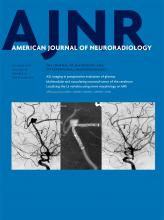Abstract
BACKGROUND AND PURPOSE: The double inversion recovery sequence is known to be very sensitive and specific for MS-related lesions. Our aim was to compare the sensitivity of pre- and postcontrast images of 3D double inversion recovery and conventional 3D T1-weighted images for the detection of contrast-enhancing MS-related lesions in the brain to analyze whether double inversion recovery could be as effective as T1WI.
MATERIALS AND METHODS: A postcontrast 3D double inversion recovery sequence was acquired in addition to the standard MR imaging protocol at 3T, including pre- and postcontrast 3D T1WI sequences as well as precontrast double inversion recovery of 45 consecutive patients with MS or clinically isolated syndrome between June and December 2013. Two neuroradiologists independently assessed precontrast, postcontrast, and subtraction images of double inversion recovery as well as T1WI to count the number of contrast-enhancing lesions. Afterward, a consensus reading was performed. Lin concordance was calculated between both radiologists, and differences in lesion detectability were assessed with the Student t test. Additionally, the contrast-to-noise ratio was calculated.
RESULTS: Significantly more contrast-enhancing lesions could be detected with double inversion recovery compared with T1WI (16%, 214 versus 185, P = .007). The concordance between both radiologists was almost perfect (ρc = 0.94 for T1WI and ρc = 0.98 for double inversion recovery, respectively). The contrast-to-noise ratio was significantly higher in double inversion recovery subtraction images compared with T1-weighted subtraction images (double inversion recovery, 14.3 ± 5.5; T1WI, 6.3 ± 7.1; P < .001).
CONCLUSIONS: Pre- and postcontrast double inversion recovery enables better detection of contrast-enhancing lesions in MS in the brain compared with T1WI and may be considered an alternative to the standard MR imaging protocol.
ABBREVIATIONS:
- DIR
- double inversion recovery
- GBCA
- gadolinium-based contrast agent
- CNR
- contrast-to-noise ratio
- © 2017 by American Journal of Neuroradiology












